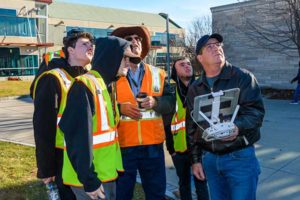Engineering tech students learn with sand and flight
Hunter Wallace
News Editor

COURTESY OF HVCC.EDU
The use of two new pieces of technology— an Augmented Reality Sandbox and a drone — have helped students better understand the curricula of their engineering technology courses since the Fall 2017 semester.
Augmented Reality Sandbox
The Augmented Reality Sandbox was developed a few years ago by scientists at the University of California at Davis and uses advanced computer software and 3D projection to create a hands-on watershed science learning experience.
Moving the sand in the box creates a landscape with elevation lines, and holding one’s hand over it forms a “cloud” that releases water to flow across the landscape.
“There’s a lot of use out of [the sandbox] because students are having a hard time understanding contour lines,” said Karl Hoegemann, technology lab assistant and certified drone pilot.
“This is something that makes contour lines very easy to understand — they can actually put their hands on contours physically and see how it looks on a contour map all at once. A lot of classes have been out of that room,” continued Hoegemann.
Faculty member Craig D’Allaird discovered the UC Davis website for the sandbox and shared it with his colleagues. With free software available online, only hardware and construction of the sandbox was needed.
Over the past few months, Hoegemann built the sandbox, which holds over 200,000 pounds of sand and belongs only to Ivy League schools outside Hudson Valley. The sandbox and the computer to help run the system were put together using parts from the college’s media department, construction lab and other areas. Other faculty members added their expertise in programming.
The sandbox, which cost an estimated total of $3,000, made its debut last semester and immediately became popular with students. Faculty members are still discovering new uses for the sandbox, but Professor Bill Darling said it’s a perfect fit for the Civil Engineering Technology’s hydraulics and drainage classes, as well as for teaching the basics of topography.
Drone
Last semester, Karl Hoegemann, a certified drone pilot, collaborated with various faculty members on ways to integrate drones into their coursework. For example, students in the Civil Engineering Technology Transportation class are asked to perform traffic studies every semester. What used to be a manual process was changed this year when Hoegemann’s personal drone hovered over the intersection of Vandenburgh and Morrison Avenues and students remotely counted cars as they passed through the intersection.
“I have to either control the drone or watch while someone else controls it,” Hoegemann said. “This drone actually came with two controllers. One is called the ‘master,’ and that’s the one that actually pilots the drone. The second controller controls just the camera. So, the second operator is able to pivot the camera 360 degrees while in flight and can control any photos or videos or infrared imaging that may be taken from his controller.”
While drones are not completely ready to handle the intricacies of certain work such as land surveying, they can create a three-dimensional map of a targeted area with a few hours.
“The drone is nothing more than a high tech tool, but what we’ve been doing this semester has been proof of concept,” said William Darling, professor of Civil, Construction, Industrial and Mechanical Technologies. “We have an idea and see if the drone can help us do it better or easier.”
Technology’s Future Role
Faculty members have noted the significance of technology like Augmented Reality Sandboxes and drones in education.
“Finding ways to reach the students and engage learning is always a challenge,” said Christine LaPlante, department chairperson of Construction, Industrial and Mechanical Technologies.
LaPlante continued, “In this new technological society, the ability to see, touch and feel becomes necessary for understanding difficult engineering concepts. The department is finding that use of these tools has assisted student success in understanding many of course concepts.”
“I’m looking forward to what’s coming because I can see that if there’s any piece of technology that’s remotely possible to get into, you can bet we [will] have it,” Hoegemann said. “We want the biggest bang for our buck for our students, and I believe that staying on the cutting edge of technology is a big step in doing that.”
